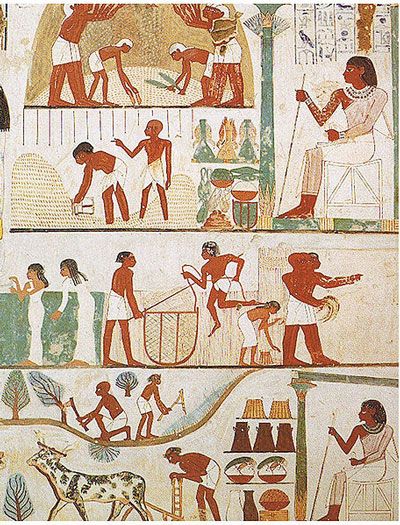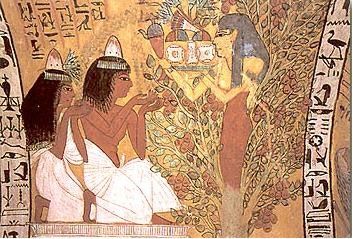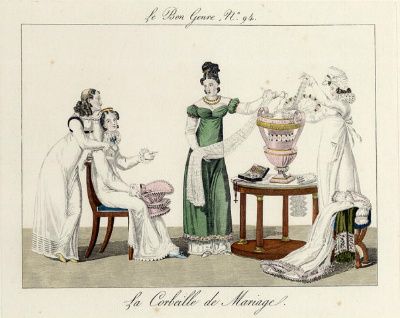
Agricultural scene from the tomb of Nakht, 18th Dynasty Thebes
Linen was the most important fabric in Ancient Egypt. Egyptian linen was EXTREMELY fine material, not like the cheap linen we think of today. It was important to maintain an absolutely perfect white garment, as immaculate linen meant that you were wealthy enough to sit around all day rather than working. A basic Egyptian textile was called a sheet or an ifd, and was fringed on all four sides for a decorative touch. Garments were shaped by elaborate pleating.

Facsimile of a scene from the Tomb of Sennedjem by Charles K. Wilkinson from c. 1922. Tomb dating from 1200 BC. At the Metropolitan Museum of Art.
While the actual garments of the Ancient Egyptians are relatively simple, they added some color and extravagance with jewelry. They wore headdresses, elaborate collars, bracelets, and other decorative accessories. These were made of gold and decorated with precious stones such as lapis. Accessories also carried various important motifs, like the eye of thoth (that famous Egyptian eye we know so well), the scarab, and the falcon.

Scene from the Tomb of Sennedjem, 1200 BC, showing a man and a woman with fragrance cones.
The Egyptians also wore elaborate wigs and hairpieces. Yup, wigs. It gets really hot in the desert, so it's much more comfortable to be able to take off your hair when you need to. Hair was set in elaborate styles with an ancient version of hair gel, according to recent archaeological evidence. Apart from the hair on the head, a hairless body was desired, so body hair was plucked and shaved. Taking care of the body was extremely important, and the Egyptians bathed frequently and applied oils for beautiful skin. They also wore fragrance cones, which were scented wax cones placed on top of the head. As the day went on, the wax would melt and perfume the wearer. And of course the Egyptians are quite famous for their make up, particularly thick black lines around the eyes, which protected the eyes from the glare of the sun.



